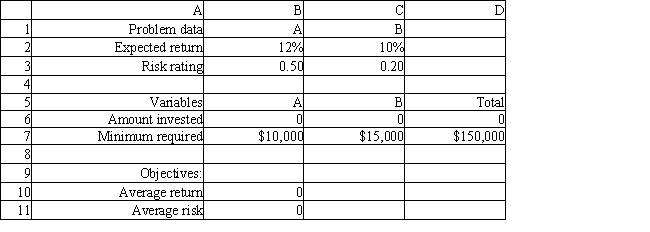Exhibit 7.2
The following questions are based on the problem below.
An investor has $150,000 to invest in investments A and B. Investment A requires a $10,000 minimum investment, pays a return of 12% and has a risk factor of .50. Investment B requires a $15,000 minimum investment, pays a return of 10% and has a risk factor of .20. The investor wants to maximize the return while minimizing the risk of the portfolio. The following multi-objective linear programming (MOLP) has been solved in Excel. 
-Refer to Exhibit 7.2. What formula goes in cell B11?
Definitions:
Journal Entry
A record in accounting that notes the details of a financial transaction in a company’s financial systems.
Raw Materials
Basic materials that are used in the production process to manufacture goods, often transformed or converted into the finished product.
Journal Entry
A record in the books of account that represents a transaction and its effect on the accounts, typically including a debit and credit.
Period Costs
Costs not directly linked to manufacturing and are charged as expenses when they occur, including sales, general, and administrative costs.
Q17: The constraint for resource 1 is
Q25: The Byte computer company produces two
Q28: Refer to Exhibit 11.12. What is the
Q41: The standardized queuing system notation such as
Q43: All of the following are benefits of
Q45: Almost all network problems can be viewed
Q48: A variable with a final value equal
Q51: Refer to Exhibit 11.19. What are the
Q61: The reduced cost for a changing cell
Q94: Refer to Exhibit 11.14. What formulas should